The Detection Algorithm Based on the Short Time Delay for Three-Phase Unbalanced Voltage Sag
Abstract
:1. Introduction
- (1)
- The detection principle and prediction model for the three-phase unbalance voltage sag are established.
- (2)
- The new algorithm for constructing the VQVS and many advantages, it also has some disadvantage such that the the steps for extracting the positive sequence and negative sequence component are explained.
- (3)
- To highlight the performance of the proposed algorithm, it has been compared with two other already proposed in the literature. It is shown that other sag detectors can provide robustness against voltage disturbances. However, the one proposed here can do it with a straightforward design and a fast transient response.
2. The Principle of the Detection Algorithm
3. Short Time Delay (STD) Algorithm
3.1. Basic Principle
3.2. Figures, Tables and Schemes
3.3. Noise Sensitivity Analysis of the VQVS
4. The Extraction of the Positive Sequence and Negative Sequence Voltage Components
5. Simulations
5.1. Transient-Response Analysis
5.2. Sag-Detection Time
6. Experiments
6.1. Hardware Setup
6.2. Results and Analysis
Author Contributions
Funding
Institutional Review Board Statement
Informed Consent Statement
Data Availability Statement
Conflicts of Interest
References
- Bollen, M. Understanding Power Quality Problems: Voltage Sags and Interruptions; IEEE Press: Piscataway, NJ, USA, 2000. [Google Scholar]
- Wang, Z.; Guo, X.; Li, J.; Wang, X. Impact of voltage sags on electricvehicle charger and critical voltage sag determination. IEEE Trans. Power Del. 2016, 31, 1397–1399. [Google Scholar] [CrossRef]
- Somayajula, D.; Crow, M.L. An integrated dynamic voltage restorer-ultracapacitor design for improving power quality of the distribution grid. IEEE Trans. Sustain. Energy 2015, 6, 616–624. [Google Scholar] [CrossRef]
- Ebrahimzadeh, E.; Farhangi, S.; Iman-Eini, H.; Ajaei, F.B.; Ira-vani, R. Improved phasor estimation algorithm for dynamic voltage restorer applications. IEEE Trans. Power Del. 2015, 30, 1467–1477. [Google Scholar] [CrossRef]
- Carlos, G.A.d.; Jacobina, C.B. Series compensator based on cascaded transformers coupled with three-phase bridge converters. IEEE Trans. Ind. Appl. 2017, 53, 1271–1279. [Google Scholar] [CrossRef]
- Wang, Y.; Bollen, M.H.; Bagheri, A.; Xiao, X.-Y.; Olofsson, M. A quantitative comparison approach for different voltage dip characterization algorithms. Elect. Power Syst. Res. 2016, 133, 182–190. [Google Scholar] [CrossRef]
- Xiao, X.N.; Xu, Y.H.; Liu, L.G. Research on Mitigation Algorithms of Voltage Sag with Phase-Angle Jump. Proc. Chin. Soc. Electr. Eng. 2002, 22, 65–70. [Google Scholar]
- Zhao, G.L.; Liu, B.Z.; Xiao, X.N.; Xu, Y.H. Application of Improved d-q Transform without Time Delay in Dynamic Voltage Disturbance Identification. Power Syst. Technol. 2004, 28, 53–57. [Google Scholar]
- Yang, Y.F.; Yan, X.W.; Lou, Y.L. An New Detection Algorithm of Voltage Sag Characteristic Quantity. Autom. Electr. Power Syst. 2004, 28, 41–44. [Google Scholar]
- Zhang, Q.C.; Xiao, Y.L. An lmproved Detection Algorithm of Voltage Sag. Trans. China Electrotech. Soc. 2006, 21, 123–126. [Google Scholar]
- Qu, Y.; Huang, C.; Jiang, Y.Q.; Zeng, Z.X. A New Detection Algorithm of Voltage Sag Applied in DVR. Trans. China Electrotech. Soc. 2013, 28, 234–239. [Google Scholar]
- Xu, Z.D.; Fan, R.X.; Deng, C.B.; Song, Y.M. lmproved Single-Phase Two-Point Sag Voltage Detection Algorithm. Electr. Energy Manag. Technol. 2015, 1, 51–56. [Google Scholar]
- Chen, G.; Zhang, L.; Wang, R.; Zhang, L.; Cai, X. A novel SPLL and voltage sag detection based on LES filters and improved instantaneous symmetrical components algorithm. IEEE Trans. Power Electron. 2015, 30, 1177–1188. [Google Scholar] [CrossRef]
- Kumar, R.; Singh, B.; Shahani, D.T. Symmetrical components-based modified technique for power-quality disturbances detection and classification. IEEE Trans. Ind. Appl. 2016, 52, 3443–3450. [Google Scholar] [CrossRef]
- Liang, C. A new time domain positive and negative sequence component decomposition algorithm. Proc. IEEE Power Eng. Soc. Gen. Meet. 2003, 3, 1638–1643. [Google Scholar]
- Xiong, L.; Zhuo, F.; Wang, F.; Liu, X.; Zhu, M. A fast orthogonal signal-generation algorithm characterized by noise immunity and high accuracy for single-phase grid. IEEE Trans. Power Electron. 2016, 31, 1847–1851. [Google Scholar] [CrossRef]
- Roldán-Pérez, J.; García-Cerrada, A.; Ochoa-Giménez, M.; Zamora-Macho, J.L. Delayed-Signal-Cancellation-Based Sag Detector for a Dynamic Voltage Restorer in Distorted Grids. IEEE Trans. Sustain. Energy 2019, 10, 2015–2027. [Google Scholar] [CrossRef]
- Liu, Y.C.; Huang, C.; Ou, L.Q.; Zhao, W.M. Algorithm for Unbalanced Voltage Sag Detection Based on dq Transform. Proc. CSU-EPSA 2007, 19, 72–76. [Google Scholar]
- Bae, B.; Lee, J.; Jeong, J.; Han, B. Line-interactive single-phase dynamic voltage restorer with novel sag detection algorithm. IEEE Trans. Power Del. 2010, 25, 2702–2709. [Google Scholar] [CrossRef]
- Granados-Lieberman, D.; Romero-Troncoso, R.; Osornio-Rios, R.; Garcia-Perez, A.; Cabal-Yepez, E. Techniques and algorithmologies for power quality analysis and disturbances classification in power systems: A review. IET Gener. Transmiss. Distrib. 2011, 5, 519–529. [Google Scholar] [CrossRef]
- Gu, I.Y.H.; Bollen, M.H.J. Time-frequency and time scale domain analysis of voltage disturbances. IEEE Trans. Power Del. 2000, 15, 1279–1284. [Google Scholar] [CrossRef]
- Rioul, O.; Vetterli, M. Wavelets and signal processing. IEEE Signal Process. Mag. 1991, 8, 14–38. [Google Scholar] [CrossRef]
- Francisco, J.; José, R.S. Comparison between discrete STFT and wavelets for the analysis of power quality events. Electr. Power Syst. Res. 2002, 62, 183–190. [Google Scholar]
- Zhao, F.Z.; Yang, R.G. Voltage Sag Disturbance Detection Based on Short Time Fourier Transform. Proc. Chin. Soc. Electr. Eng. 2007, 27, 28–34. [Google Scholar]
- Gencer, Ö.; Semra, Ö.; Tank, E. A new approach to voltage sag detection based on wavelet transform. Int. J. Electr. Power Energy Syst. 2009, 2, 133–140. [Google Scholar] [CrossRef]
- Xiong, L.L.; Liu, H.J.; Fu, Z.W. Voltage sag analysis based on wavelet package transform. Power Syst. Prot. Control 2004, 11, 8–12. [Google Scholar]
- Wang, K.X.; Song, Z.X.; Chen, D.G. Interference Source Identification of Voltage Sag in Distribution System Based on Wavelet transform. In Proceedings of the Chinese Society for Electrical Engineering, Dalian, China, 21–23 June 2003; pp. 29–34. [Google Scholar]
- Liu, L.G.; Jia, W.S.; Xiao, X.N. Measurement Algorithm of Voltage Sag by Wavelet Transform and Rms Algorithm. Autom. Electr. Power Syst. 2003, 11, 30–33. [Google Scholar]
- Xuan, J.H.; Xiao, S.M.; Feng, L.H. Rapid Detection of Voltage Sag of the Micro-grid Based on DOS-transform. Electr. Switchg. 2019, 57, 16–19. [Google Scholar]
- Xiao, Z.L.; Gong, R.X.; Chen, S. Detection of voltage sag by a modified incomplete S-transform. Power Syst. Prot. Control. 2015, 43, 62–68. [Google Scholar]
- Stockwell, R.G.; Mansinha, L.; Lowe, R.P. Localization of the complex spectrum: The S transform. IEEE Trans. Signal Processing 1996, 44, 998–1001. [Google Scholar] [CrossRef]
- Li, L.; Jianmin, Y.; Yuxiang, L.; Haijun, T.; Zhaosheng, Z.F.; Xu, Y. A Voltage Sag Detection Algorithm Based on Modified S Transform with Digital Prolate Spheroidal Window. IEEE Trans. Power Deliv. 2021, 36, 997–1006. [Google Scholar] [CrossRef]
- Hasan, H.; Sumaiya, M.; Kashem, M.; Sutanto, D. Detection and Characterization of Time-Variant Nonstationary Voltage Sag Waveforms Using Segmented Hilbert-Huang Transform. IEEE Trans. Ind. Appl. 2020, 56, 4563–4574. [Google Scholar]
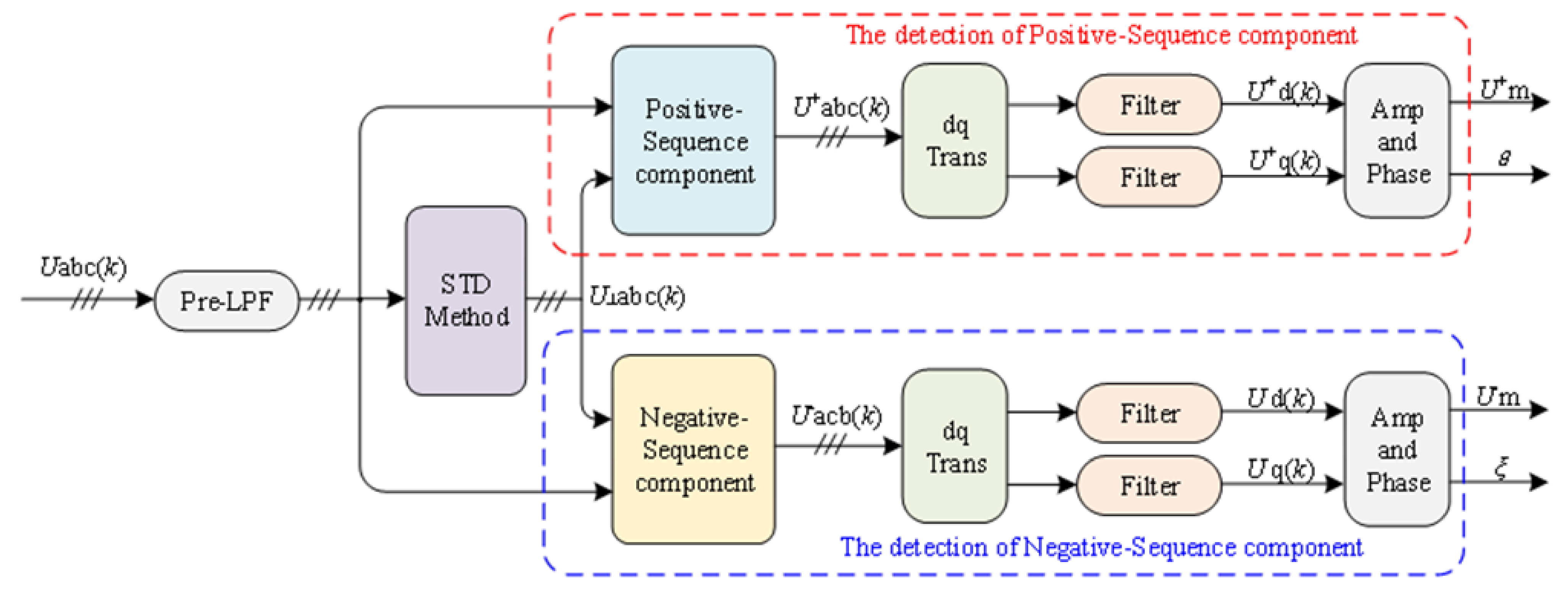

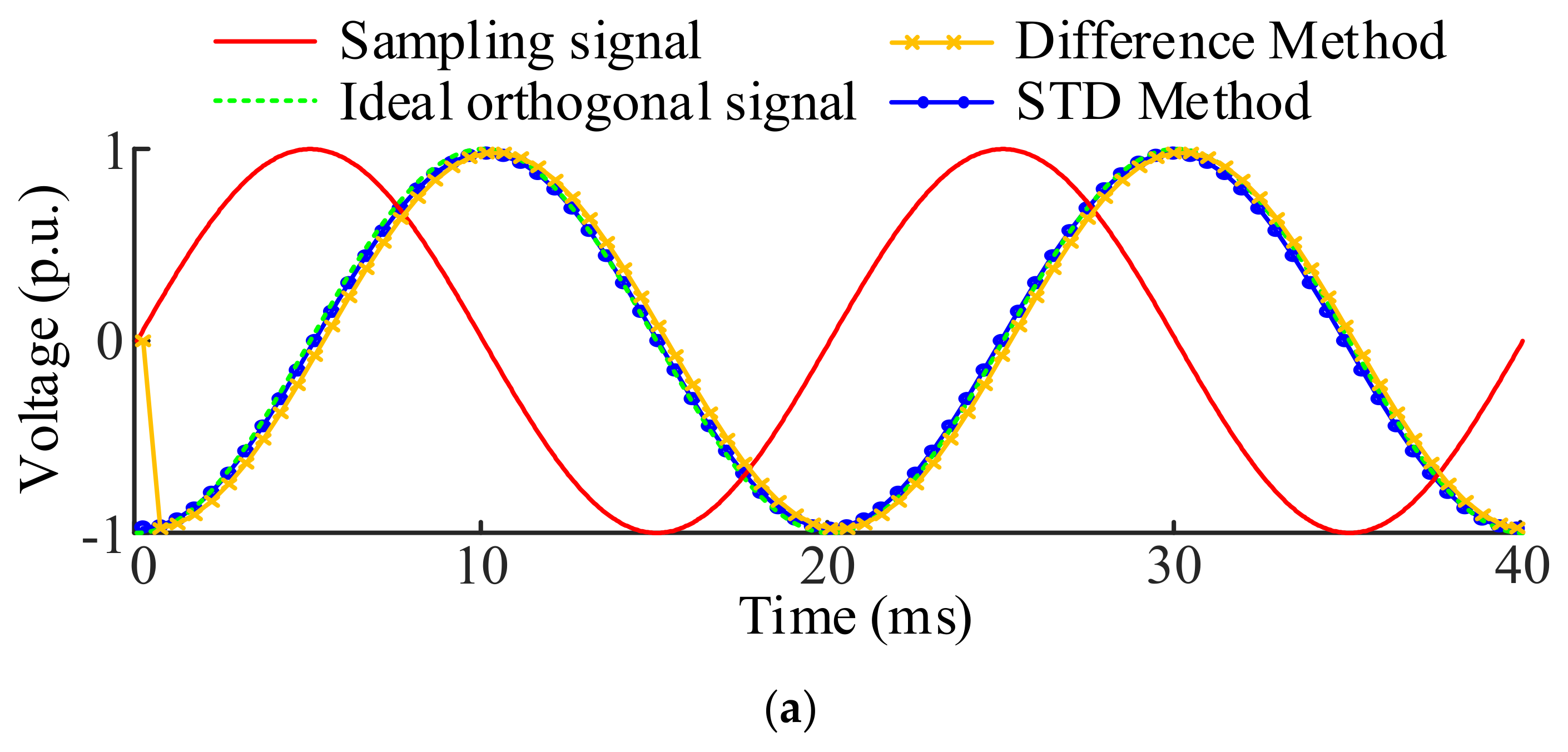
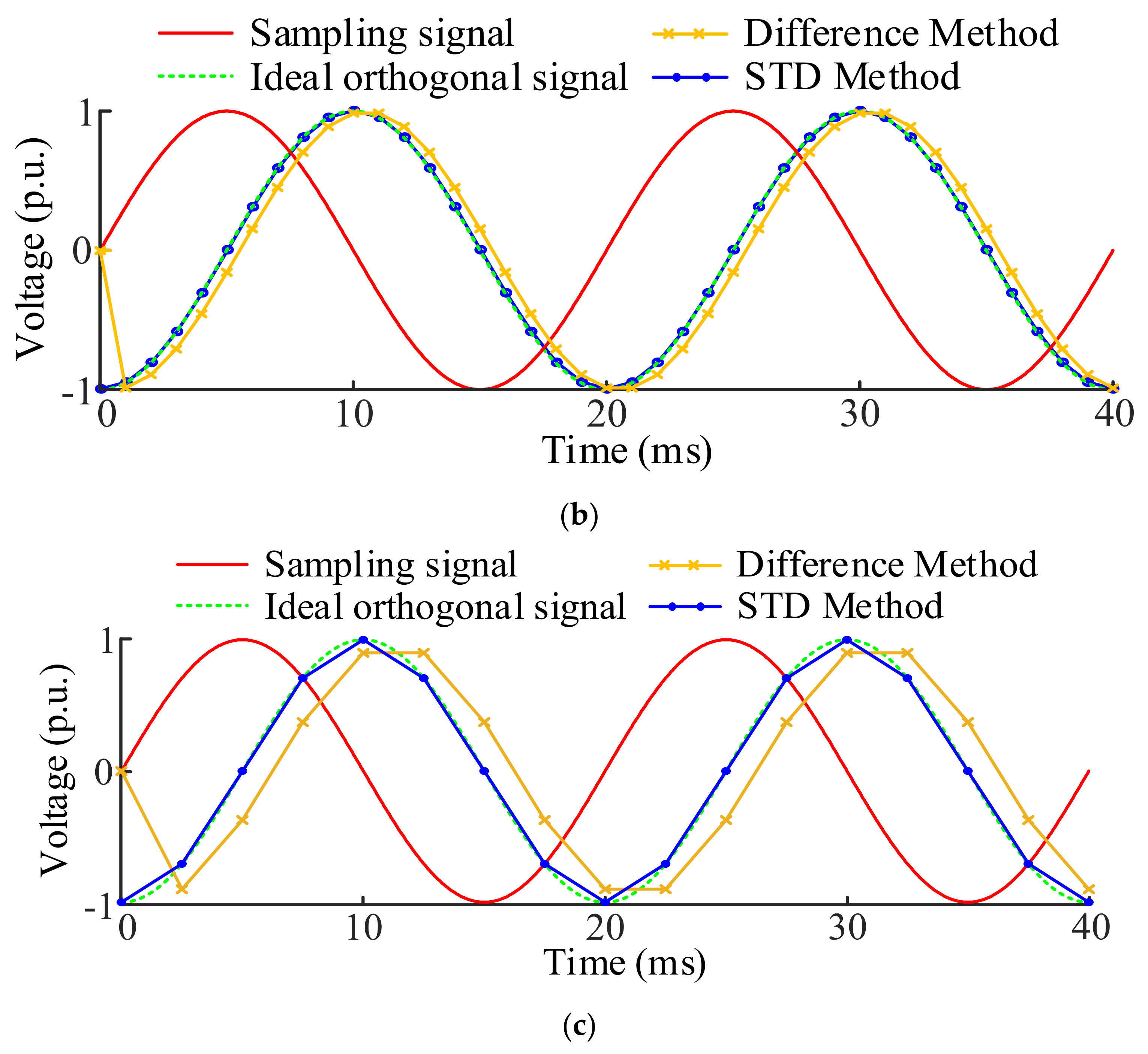
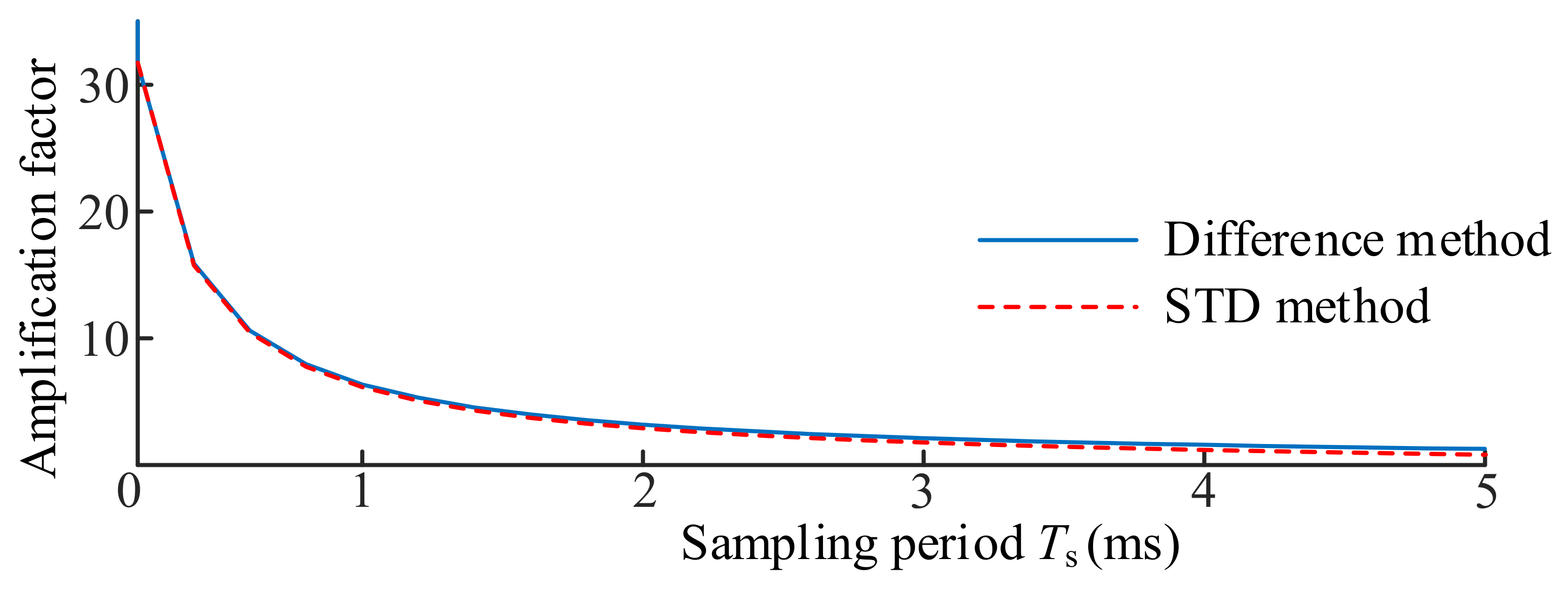

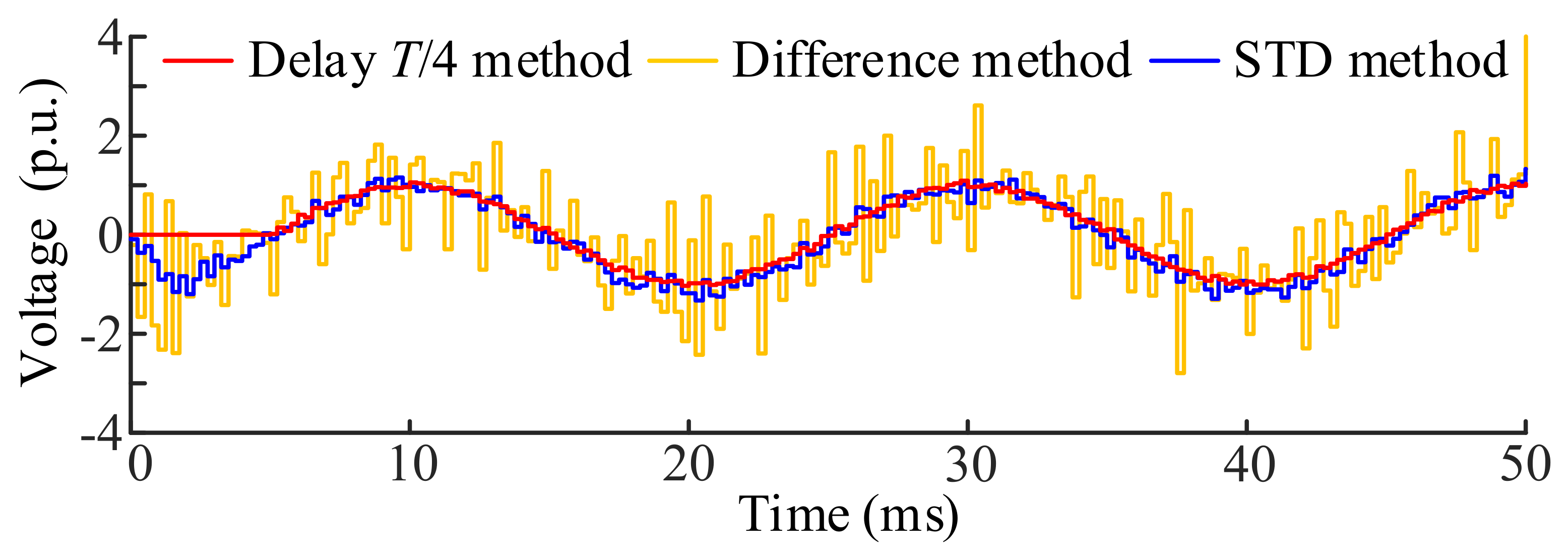
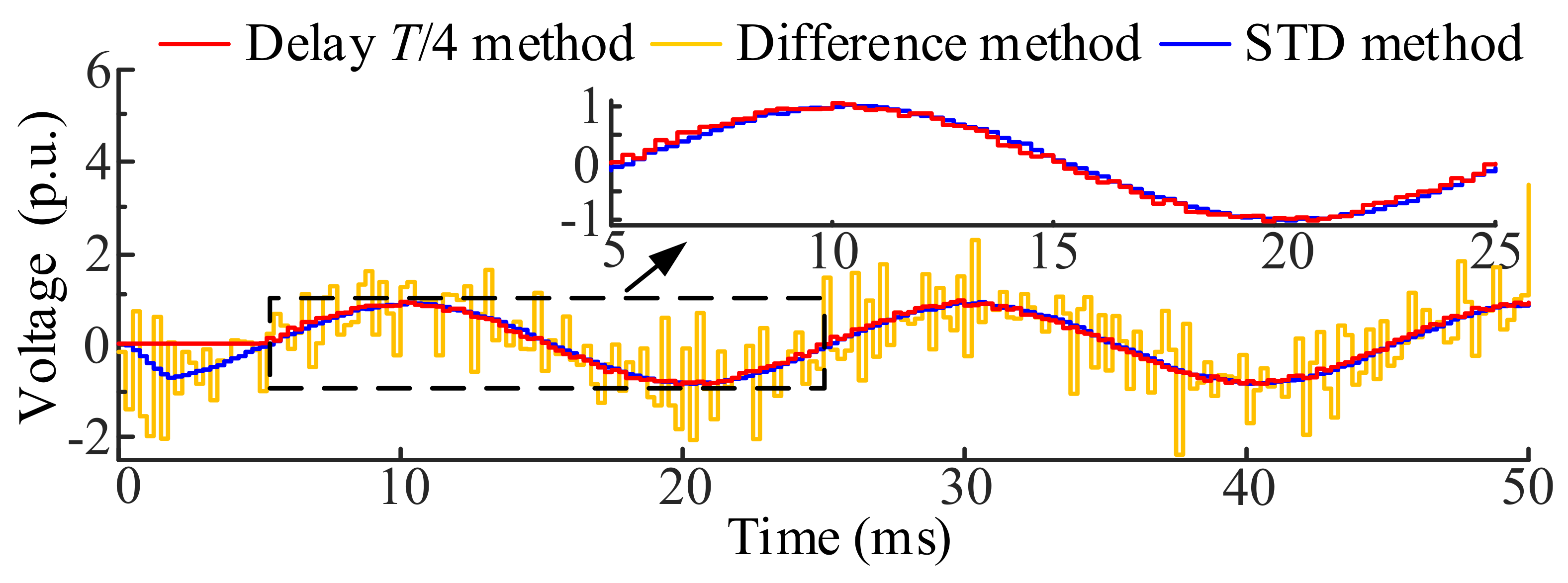



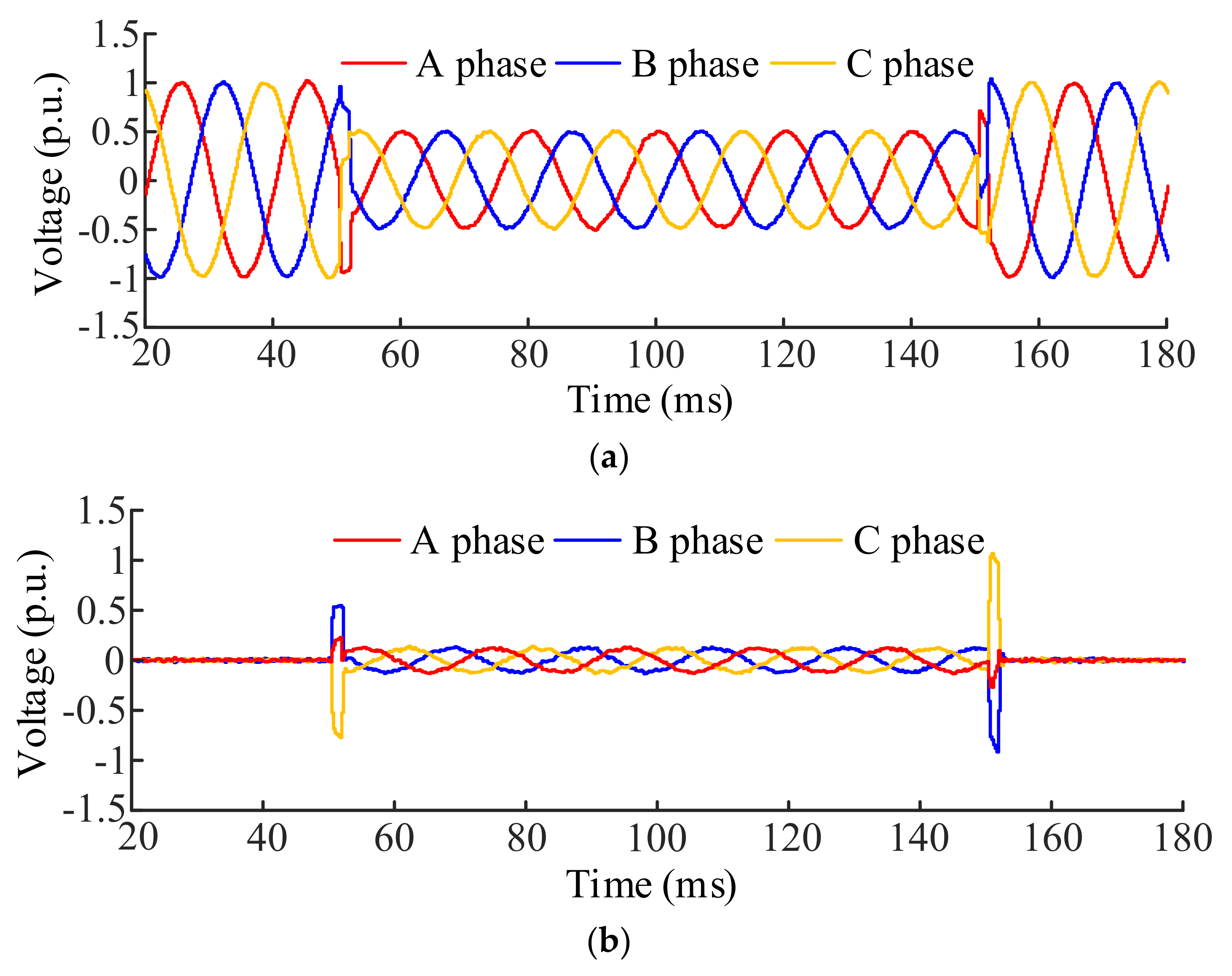



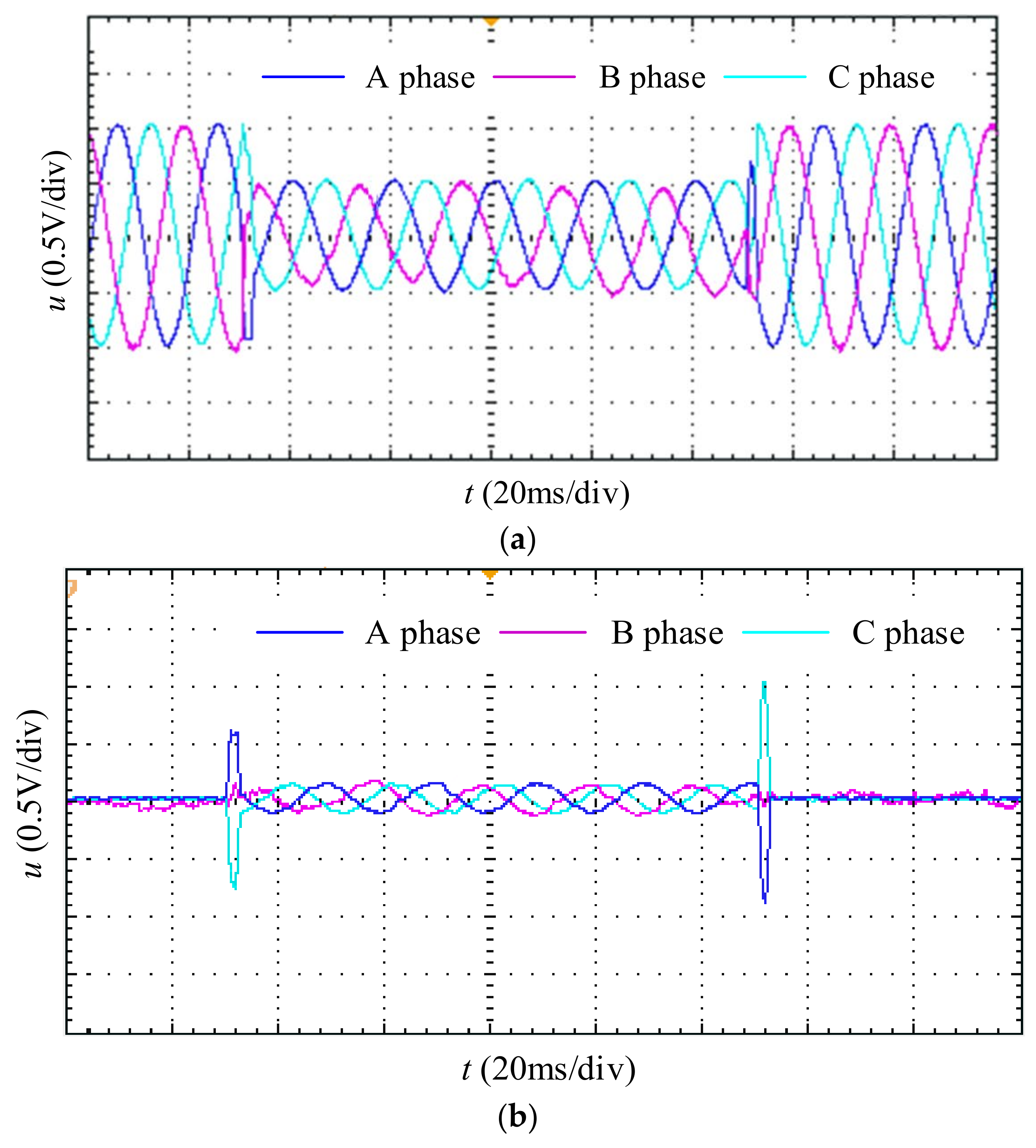
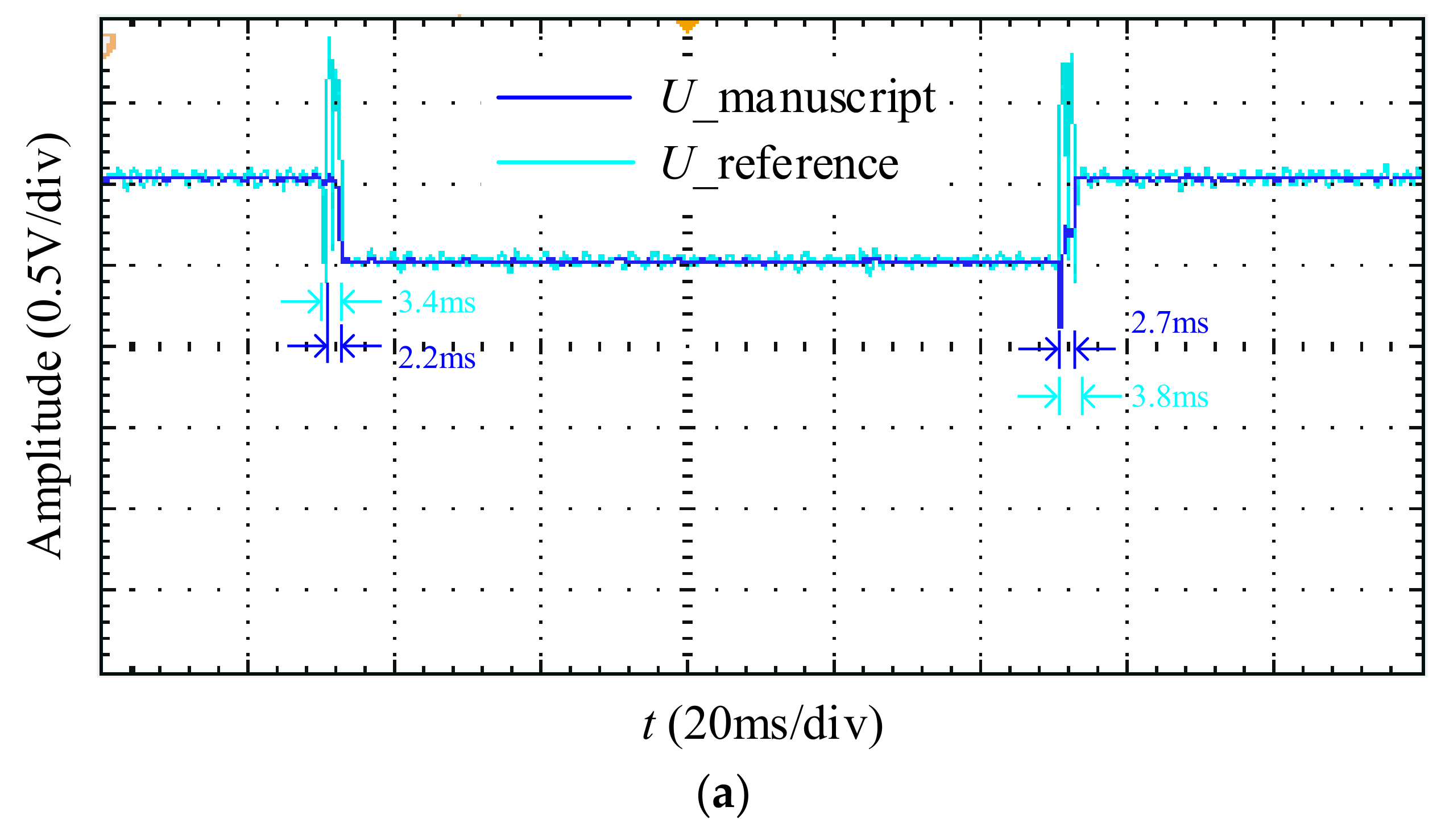
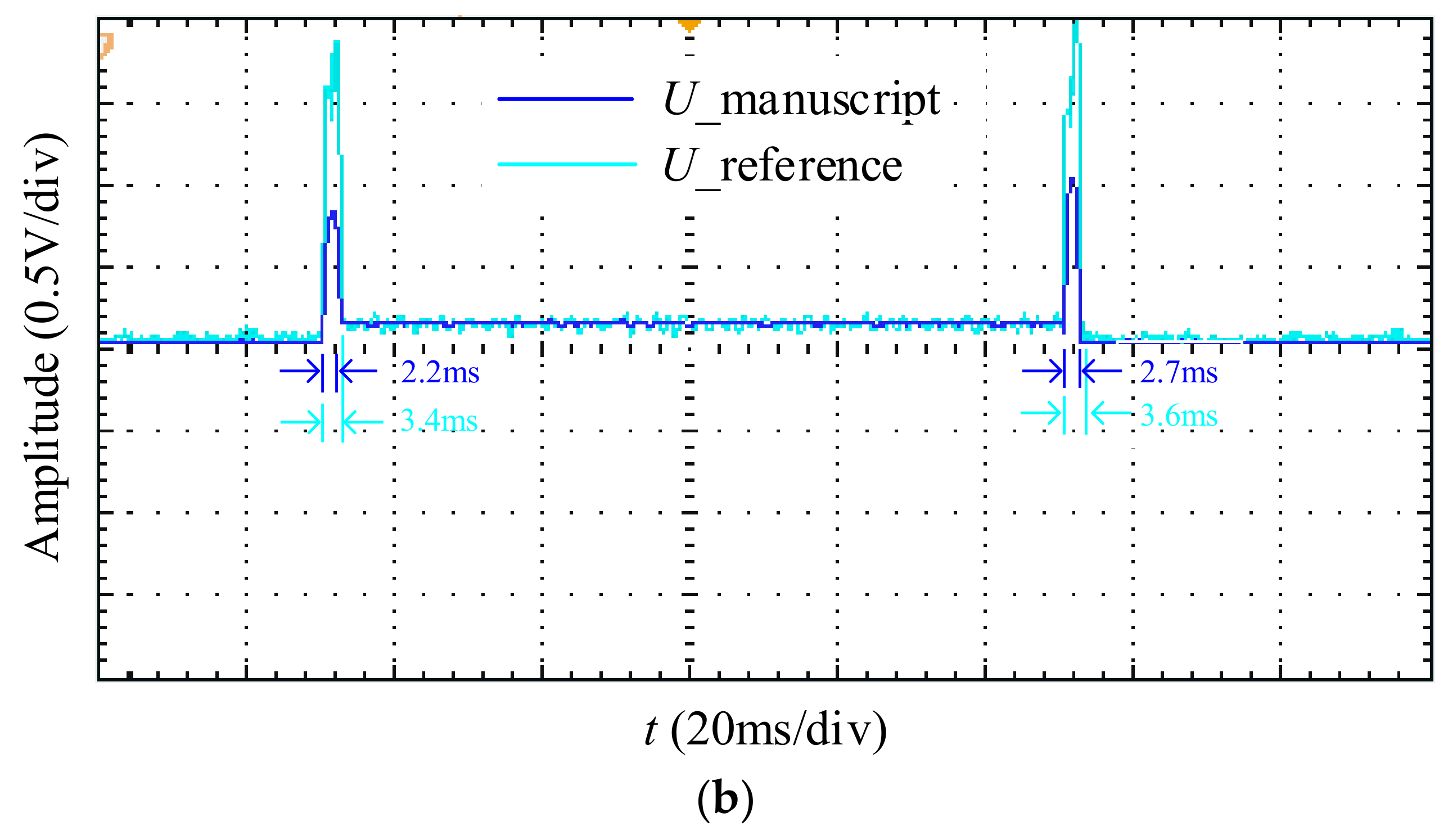
Publisher’s Note: MDPI stays neutral with regard to jurisdictional claims in published maps and institutional affiliations. |
© 2022 by the authors. Licensee MDPI, Basel, Switzerland. This article is an open access article distributed under the terms and conditions of the Creative Commons Attribution (CC BY) license (https://creativecommons.org/licenses/by/4.0/).
Share and Cite
Hao, X.; Wang, Y.; Sun, S.; Jiang, S.; Liu, Y. The Detection Algorithm Based on the Short Time Delay for Three-Phase Unbalanced Voltage Sag. Electronics 2022, 11, 2646. https://doi.org/10.3390/electronics11172646
Hao X, Wang Y, Sun S, Jiang S, Liu Y. The Detection Algorithm Based on the Short Time Delay for Three-Phase Unbalanced Voltage Sag. Electronics. 2022; 11(17):2646. https://doi.org/10.3390/electronics11172646
Chicago/Turabian StyleHao, Xiaohong, Yangtao Wang, Shuaizheng Sun, Shan Jiang, and Yan Liu. 2022. "The Detection Algorithm Based on the Short Time Delay for Three-Phase Unbalanced Voltage Sag" Electronics 11, no. 17: 2646. https://doi.org/10.3390/electronics11172646
APA StyleHao, X., Wang, Y., Sun, S., Jiang, S., & Liu, Y. (2022). The Detection Algorithm Based on the Short Time Delay for Three-Phase Unbalanced Voltage Sag. Electronics, 11(17), 2646. https://doi.org/10.3390/electronics11172646





